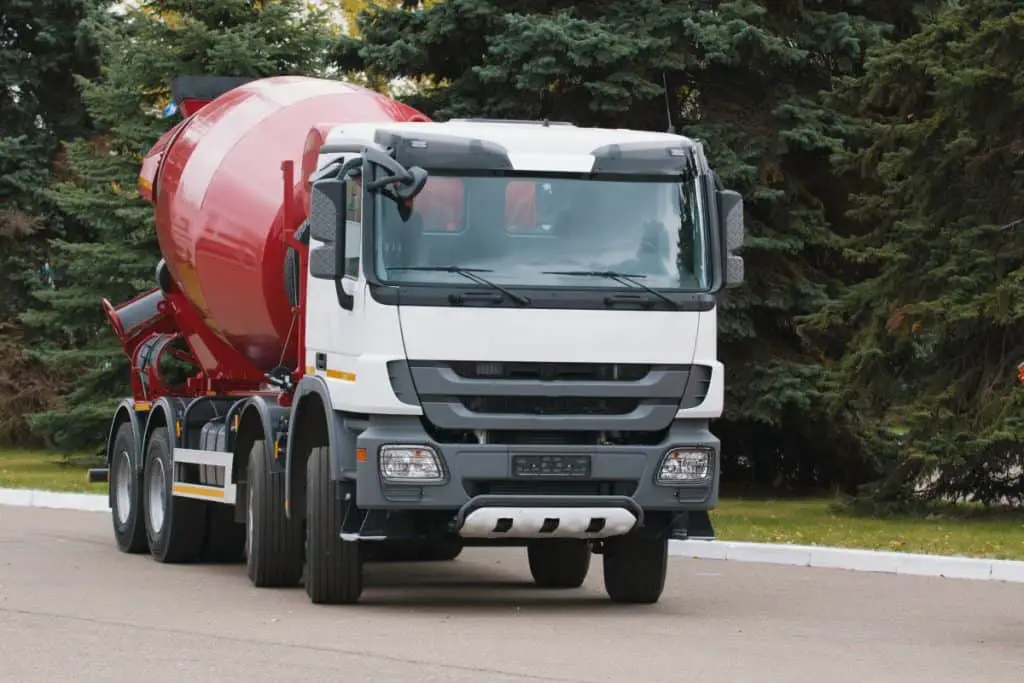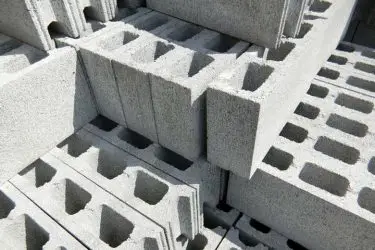A concrete mixer truck refers to a concrete mixer mounted on a truck or trailer to deliver a fresh and even mixture of cement concrete. The truck is essentially provided with a rotating tank in the top and inclined on an almost horizontal axis. But how do they work?
Concrete mixer trucks work thanks to the rotary movement of its tank, which allows the continuous mixing of the concrete and prevents its segregation during transport. However, concrete can’t stay in the trucks for too long.
In this article, you’ll learn more about concrete mixer trucks, how they work, the different types of trucks, and the pros and cons of each one. Let’s begin with the concrete mixer truck’s main characteristics.

Table of Contents
What Is a Concrete Mixer Truck?
The concrete mixer (also called the mixer truck) is a truck used for transporting and pouring ready-to-use concrete on a site.
It has a rotating tank used to stir the concrete and maintain its homogeneity until pouring, as well as a 3-meter-long chute.
Well positioned, it allows the concrete to flow into the formwork, directly from the end of the truck.
A mixer truck refers to a truck specializing in transporting fresh concrete. The truck’s main part is a spinning top-shaped tank that is tilted on an almost horizontal axis.
How Do Concrete Mixer Trucks Work?
The mixer truck spins slowly, allowing for continuous mixing of the concrete to prevent “tangling” during transport to the job site.
Contrary to popular belief, the movement does not prevent concrete from setting. Thus, to keep all its qualities, the concrete must not stay for too long in the truck (one hour maximum).
The continuous mixing is also intended to complement the careful mixing of the concrete plant.
The tank’s interior is provided with an endless screw that drives the concrete to the bottom of the tank when it turns in one direction (stirring operation) and towards the open top of the tank when the spindle molder is rotated in the opposite direction (emptying procedure).
Thus the router can be entirely emptied without having to be tilted.
What Are the Components of the Mixer Truck?
The concrete mixer truck is equipped with the following:
- Funnel located above the opening. It facilitates the truck’s filling under the concrete batching plant.
- Removable pipes (also called “chutes”). They allow the concrete to flow directly to the desired location.
- Carrier. The forwarder is the truck carrying all the material necessary to ensure the safe delivery of concrete. Its configuration varies from 3 to 4 axles depending on the volume of the tank transport.
- Tank. The tank is the element for transporting concrete from the concrete batching plant to the site. Its volume can vary from 4 to 8 m³.
- Tank rotation and cleaning system. The tank’s rotation is essential because it allows the concrete to remain homogeneous during transport and be discharged on the job site. This rotation is provided by a system powered by the truck engine.
- Water tank. Above the rotation system is a water tank that can hold approximately 400L. The water in this tank is intended to clean the concrete tank when it has been poured.
- Helical blade. The tank consists of a system (helical blades) allowing the concrete to remain in motion during transport and to raise it up to pour it onto the site.
- Filling and emptying system. At the rear of the vehicle are the filling hopper (upper part) and the emptying system (lower part). The chute’s position for pouring the concrete can be adjusted to facilitate the pouring of concrete.
- Extension. The extension is usually located at the rear of the truck, above the fenders. The extensions’ material can vary (plastic or steel), which allows increasing the distance of the concrete pouring (about 3m).
How Much Concrete Can Mixer Trucks Transport?
Depending on their size, trucks can transport from 4 m³ to 10 m³ of concrete. The rotors come in one of three forms of carriers and a semi-trailer:
- The 4×2 or 4×4 (19 tonnes maximum) can carry 4 m³ of concrete (9.2 tonnes)
- The 6×4 (26 tonnes maximum) can carry 6 m³ of concrete (13.8 tonnes)
- The 8×4 (32 tonnes maximum) can carry 8 m³ of concrete (18.4 tonnes)
- The 2-axle semi-trailer (38 tonnes maximum) can carry 10 m³ of concrete (23 tonnes)
The mixer trucks are sometimes equipped with an on-board conveyor belt or a pump to deliver the concrete directly to the pouring site. I’ll cover each of these different types of trucks in the next section.
What Are the Different Types of Concrete Mixer Trucks?
The Concrete Mixer Truck
As I explained above, the mixer truck has been specially designed for transporting fresh concrete.
The removable pipe called a “chute” located at the rear of the truck allows it to pour concrete directly onto the structure’s part to be covered.
| Pros | Cons |
| Ensures concrete quality | Obliges to provide a significant margin of maneuver for access |
| Produced in a concrete batching plant | |
| Saves time on the job site |
The Concrete Conveyor Truck
The conveyor truck is a standard mixer truck to which has been added what is called a conveyor belt. This type of truck will be helpful if your site is difficult to access by the usual means.
With the help of this mat, you will evenly pour the concrete where you want it.
The conveyor truck is suitable for unloading 12 to 16 m, depending on the model, and provides time and labor-saving.
| Pros | Cons |
| Ensures concrete quality | Not all types of concrete are compatible with this truck |
| Produced in a concrete batching plant | Reduces the volume of concrete transported, due to the weight of the belt on the mixer truck |
| Saves time on the job site | |
| Brings concrete to the right place more easily and quickly | |
| Generates a financial gain, because you will need fewer people to transport the concrete |
The Concrete Pump Truck
Unlike a standard mixer truck, a concrete pump truck is not equipped with a concrete tank but with a pump. The pump directly integrated into the truck consists of a hydraulic arm capable of unfolding over several meters.
The pump truck allows the pouring of concrete in areas that are inaccessible by the usual means, in addition to the mixer truck.
A concrete pump is intended for large-scale or inaccessible works. Thus, this concrete pump truck allows pouring at height, over any distance, and without direct access (for example, a swimming pool at the back of a house).
| Pros | Cons |
| Ensures concrete quality | Not all types of concrete are compatible with the type of truck. |
| Produced in a concrete batching plant | Reduces the volume of concrete transported, due to the weight of the belt on the mixer truck |
| The concrete is evenly distributed on the site | Significant cost |
| Allows access to difficult areas | |
| Reduction of the workforce | |
| Reduces the risk of accidents associated with transporting concrete at height |
How To Estimate the Delivery Price of Concrete
The price of the delivery of concrete via mixer trucks depends on many variables:
- The presence of additional equipment
- The quantity of concrete
- The location of your site
The Location of Your Site
A concrete mixer’s price depends on the geographical distance between your site and the concrete plant providing delivery. Most of them include more or less high shipping costs in the gross price of the loaded router.
Please note: in some regions, even if the geographical distance is only a few kilometers, delivery costs may be higher than in the provinces. In fact, the concrete mixer has to use very busy axes, and deliveries take longer.
The Type of Delivery Truck
Depending on your site’s access conditions, you may have recourse to delivery by a standard concrete mixer, conveyor truck, or even pump truck.
You should opt for one or the other handling mentioned above equipment. The delivery price will be correspondingly higher.
After determining the type of truck suitable for pouring your slab or your concrete foundations, you will need to estimate the number of trucks required to transport your raw material.
And yes: while a conventional concrete mixer can contain up to 8 m³ of concrete, a conveyor truck has a maximum capacity between 6 and 7 m³.
The Type of Concrete Chosen
Not all concrete sites require the same type of raw material. The price of concrete for swimming pool slabs is not the same as the agricultural paving price, for example.
You can then add various additives such as a retarder, a setting accelerator, a water repellent, or a plasticizer to the raw concrete.
These will increase the unit price per m³ of concrete, and therefore your delivery by concrete mixer.
Read more: Concrete Pricing Guide: All the Facts and Figures
Final Thoughts
The use of concrete mixer truck delivery can significantly simplify your workload. Having concrete delivered has 2 main advantages:
- You won’t need to prepare the concrete, which is a real time-saver, and you will conserve your energy for the rest of the job.
- You will obtain concrete that meets high-quality standards.
But before placing an order, remember that concrete is an extremely dense material. Make sure to calculate the exact quantity you need since 1 m³ equals approximately 2.5 tons of concrete.



